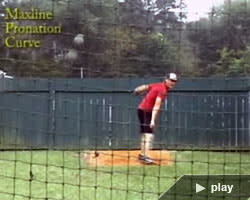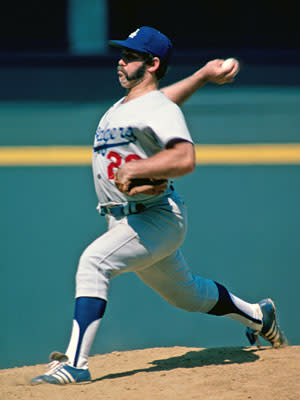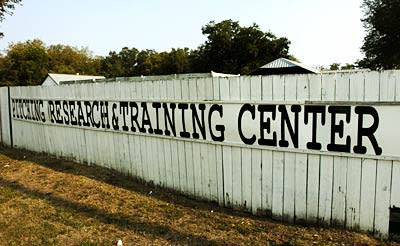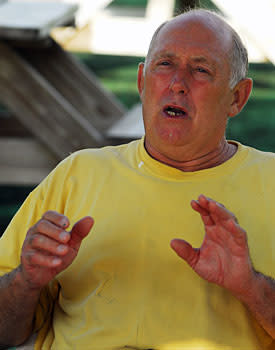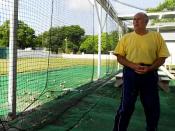Outside pitch
|
ZEPHYRHILLS, Fla. – The believer sat in seat 27D. The non-believer sat in 18A. The American Airlines flight last week from Chicago to Tampa was probably the closest they would ever come to one another.
The believer spends most of his time in a backwoods Florida town where he pays $10 a day to learn how to pitch and $10 a night to live in a ramshackle house where ants crawl on the floor and bean burritos cake the microwave walls. Dr. Mike Marshall teaches him. Marshall won a Cy Young award with the Los Angeles Dodgers in 1974, earned his Ph.D. in exercise physiology four years later and in the 30 years since has developed a motion that he believes could completely eradicate pitching-arm injuries, if only the right people would listen.
The non-believer runs the Chicago Cubs, and he wasn't terribly interested in what Mike Marshall had to say.
Maybe it was dumb luck, or maybe it was fate. Either way, Joe Williams, the believer, was not about to pass up the chance to spread his shaman's gospel to Jim Hendry, the Cubs' general manager.
So Williams reached into his laptop bag and grabbed a pen. He tore a sheet of paper from his bible, the pitching guide Marshall wrote. Since January, Williams, a former New York Mets minor-league pitcher looking for an entrée back into organized baseball, had spent every day with Marshall, learning the motion that could end elbow-ligament transplants, end shoulder reconstructions, even end the tragicomedy Hendry has endured the last four years with the recurring arm troubles of young stars Mark Prior and Kerry Wood.
Almost every day, Marshall talks about what he could do if given time with Prior and Wood, and Williams heard it often enough that when he put his pen to the piece of paper in front of him on Flight 1780, he did so with the passion of a true acolyte.
Jim,
You need to come to Zephyrhills, Florida. "Doc" (Mike Marshall) can show you how to injury-proof your pitchers, make them throw harder and throw higher-quality pitches.
P.S. – I love what you did with the Cubs this year. I hope to see you in the playoffs. And, by the way, Prior and Wood can be fixed without surgery.
He didn't even bother signing his name. He folded the letter, handed it to a flight attendant, asked her to give it to the man wearing the blue shirt in 18A and slinked down in his seat.
He didn't want to see Hendry react the way everyone else in Major League Baseball does when they hear Mike Marshall's name.
Marshall is 64 years old, impish and hyperkinetic. At 5-foot-8½, he looks more Ph.D. than ex-ballplayer. He still holds major-league records for games pitched in one season (106), relief innings pitched (208 1/3) and consecutive games for a pitcher (13), all set with the Los Angeles Dodgers in his 1974 Cy Young season. Everyone around baseball figured Marshall some kind of genetic freak, or maybe a masochist.
|
He was just ahead of his time. Almost 40 years ago, when he started the studies toward his doctorate at Michigan State, Marshall had questions about how to throw a baseball without injuring himself. Millions of pitches, thousands of feet of high-speed film and hundreds of adjustments later, he believes knows the answers better than anyone in the world.
"I'm a researcher," Marshall said. "People forget that about me. That's where my heart is. I pitched baseball, really, as the lab experiment of my research to see if it worked. Turned out it did. I don't need any more validation that I know something about baseball.
"I know what works. That's the greatest truth there is. I have a responsibility to give it back. Nobody wants it? Hey. That's not my problem."
Marshall likes to tell the story about how he diagnosed Tommy John with the torn ulnar-collateral ligament that led to John's eponymous surgery, and how Marshall's suggested regimen – exercises with an iron ball, like a shot put – strengthened John's arm enough to pitch another 13 seasons after the surgery.
"We would just look at him and go, 'He's kind of wacko,' " said John, Marshall's teammate for three years with the Dodgers. "Yet you saw these feats. What I saw him do, there had to be a reason for it."
Fixing teammates inside the clubhouse wasn't enough for Marshall. His findings were too important. So on Christmas Day in 1999, he opened his training center, fenced in by a fading white picket, off U.S. Route 301, where trucks rumble and drown out the grunts of his students.
Some days it sounds like a pig farm with all the noise. Marshall has expanded the exercise far beyond the 6-, 10- and 15-pound iron balls. The students, usually half a dozen ranging from 18 to 25 years old, are mostly marginal pitchers who want to pitch in college or maybe independent ball. With a wrist weight ranging from 15 to 30 pounds tethered to their pitching arm, they swing their pitching arm straight down like a pendulum, lift it over their ear and follow through with a hard pronation, turning the wrist outward with the thumb pointing down.
Marshall is convinced these actions can help save baseball from one of its great scourges. The rest of the motion is simple. No leg kick. No rotating the hips back toward second base. Facing the hitter, the pitcher steps with his glove-side foot and rotates his other leg with such fury his back almost ends up parallel to home plate.
|
One of Marshall's students, for lack of a better description, said "we kind of throw like a girl."
And yet the motion comes straight from the laboratory. Following Marshall's rookie season in 1967, when his poor delivery caused shoulder pain, he used high-speed film to analyze himself and noticed that if a pitcher pronates his forearm, it protects his elbow and shoulder. Marshall continued to refine the motion, adding the pendulum swings, where musculature prevents elbow-ligament damage, and the step forward, to prevent the arm from flying out and locking up. Marshall's theory: Apply all force toward home plate instead of wasting it laterally with complicated wind-ups.
Whatever Marshall's students thought they knew he makes them forget. They learn a new vocabulary to complement the new motion. Maxline is a pitch that comes in on the arm side of the plate, a torque pitch to the other. They know a lat is really a latissimus dorsi, plus the proper names for the other 35 muscles used in the pitching motion.
In one week with Marshall, a pitcher throws more than he would in a month with an affiliated team. It's every day for 90 minutes, with the wrist weights, the iron ball and weighted lids from 4-gallon drums or footballs to help learn the release of a pronation curveball. Sometimes the lids go flying like Frisbees, so every inch of the 16-by-12-foot nets is necessary. Then it's at least 50 pitches with real baseballs, usually more.
More than 100 students have gone through Marshall's 280-day program, and he claims not one has left injured. Williams was cut by the Mets in 2006 after they told him a magnetic resonance imaging revealed a torn labrum in the shoulder. A week after starting Marshall's program, Williams' pain disappeared.
"Have you ever had surgery on your labrum?" Marshall said.
"No," Williams said.
"And do you ever have pain throwing as hard as you can today?" Marshall said.
"No," Williams said.
"This is Jeff Sparks," Marshall said. "He is the most highly skilled pitcher in the world. And nobody will hire him."
Jeff Sparks, 35, temples graying, scowling like Billy Bob Thornton, is Mike Marshall's greatest student and greatest success. Right now, he sells home-and-garden products at Lowe's. He also goes to firefighter school. In December, he'll take EMT certification training.
|
In the meantime, Sparks keeps showing up at Marshall's facility, just to throw on an undersized mound covered by gnarly turf.
"Just watch," Marshall said, "and you're going to see a curveball that if the baseball world ever uses hitters will have no chance. Nobody throws a better curveball than Jeff Sparks."
Seven years ago, Sparks started the season in the Tampa Bay Devil Rays bullpen. His reputation was well-established: Sparks was a malcontent, like Marshall, only 30 years younger. The Cincinnati Reds drafted Sparks in 1995, tired of his act and, a few weeks after he punched a wall and broke his hand in '97, released him.
To have made the major leagues, then, was a testament to Sparks' ability. He played at West Texas A&M University when Marshall coached there in the '90s. At first, Sparks shunned the wrist weights, the iron ball, the fancy medical terminology, Marshall's whole shtick. When he saw his teammates gain 3, 4, 5 mph on their fastballs, Sparks felt sorry for himself, drank too much beer and returned to his dorm room at 3 a.m. to do a set with the wrist weights.
He hasn't stopped. Not after the Devil Rays released him despite striking out 41 over 30 1/3 innings and not after he got released from an independent league for challenging his manager to a fight and not after his wife left him.
Over his career, Sparks averaged almost six walks per nine innings, and in his last outing before the Devil Rays shipped him off, he threw balls on 12 of 14 pitches and found himself on the Everlast end of a verbal beating from his frustrated catcher, Mike DiFelice. Enough signs are there for Sparks to at least consider the inevitable.
"Baseball," Sparks said, "is not going to pay the bills.
"But," he added quickly, "I could pitch in the big leagues right now. I'm good. Plain and simple. I'm better today than I was in '99, 2000."
In March, Sparks went to the Detroit Tigers tryout camp for the sixth consecutive year. The scout's radar gun had him at 83 mph. He's certain it was slow and thinks he can top out in the high 80s.
"I don't know why they don't sign me," Sparks said. "Maybe it is a conspiracy against Mike."
Marshall nodded.
"Put it this way," Sparks said. "If this way of throwing becomes the mainstream, what does every pitching coach who has been preaching the traditional pitching motion forever and has no idea how to teach this have?"
Sparks smiled, then chuckled.
"No job."
Here is the part where everyone calls Mike Marshall a lunatic, where they laugh at his motion, attack his science, scoff at his claims and roll their eyes.
|
Because for all of the triumphs Marshall sees, the baseball world sees him for what he hasn't done, and that is consistently produce major-league-caliber players. And so develops the Catch-22: Teams think Marshall is too much of a kook to send him top-of-the-line talent and elite players avoid him because they don't want any sort of associated stigma.
"Mike Marshall thinks I'm nuts, God bless him," said Tom House, the former big-league reliever, longtime pitching coach for Prior and, yes, a frequent target of Marshall's jabs. "I really admire his passion about what he does. But he's not the only one who does it."
Any suggestion that Marshall adapt his program – mix his motion with the traditional motion to make the transition easier, or cut out the terminology to focus on the end rather than the means, or perhaps collaborate with others in the growing field of biomechanics – is met with a stern no.
"I called him a few years ago and said, 'Tell me about your stuff,' " said Dr. Glenn Fleisig, the biomedical engineer who works alongside top baseball surgeon Dr. James Andrews at the Alabama Sports Medicine Institute. "He said no. I said, 'Can I tell you?' And he said he didn't want to hear what any other researcher is doing, that he never read or listened to anything because he didn't want to be accused of stealing. The concept of a researcher who's speaking up but won't listen is a big turn-off."
Fleisig questions a large chunk of Marshall's motion. While the idea of directing force toward home plate and only home plate makes sense logically, Fleisig said, "We were dealt elbow joints and knee joints and hip joints." In Fleisig's mind, pitchers achieve maximum velocity when they coordinate those joints, not pronate their wrists and use pendulum swings.
As averse as Marshall is to his peers' theories, he at least respects the science behind them. For baseball executives, who he believes take pride in their ignorance, Marshall saves a special kind of repugnance.
|
"I got tired of appeasing the stupid," Marshall said. "How long does a blonde have to act like a moron before she gets a date? These people (in organized baseball) are idiots. They don't know a damn thing. The thing is, they're powerful. They get the kids and can destroy them. And they do."
He knows it takes just one – one owner, one GM or one farm director willing to risk his reputation, to draft five or six kids high school kids who throw 90 mph in the late rounds, or sign some raw pitchers from the Dominican Republic or Venezuela, and send them to Marshall to use as two-year guinea pigs.
No GM, of course, would risk his reputation. Baseball greets convention with puckered lips.
"It's so far afield from the traditional, normal method," Braves GM John Schuerholz said. "Not many people I've talked to would be comfortable embracing a concept that's so basically diametrically opposed to the teachings of baseball."
Problem is, the teachings – the same pitching motion for the last century – have led to arm breakdowns that stifled, shortened or ended careers. So in the mid-'90s, Marshall sent a letter to all 30 teams offering his services. No one bit. He called GMs he knew from his playing days and never heard back.
Only once did Marshall get anywhere. Earlier this decade, the Reds sent three injured pitchers to rehabilitate with him. Within weeks, Marshall said, the Reds stopped paying the players and they quit. Jim Bowden, currently the Washington Nationals GM and the Reds GM at the time, said he does not remember sending players to Marshall, though he'd be interested in hearing about Marshall's pitching motion.
"Actually, I'm not sure I would," Bowden said, "but I would have our people listen to him."
And still, in spite of all the skepticism from the executives they want to impress most, they're here, Joe Williams and Charlie Long and Clint Wilson and Alfredo Caballero and Jason Schmiedel and Derek Laughman and Mike Farrenkopf and Sam Buchanan, names you've never heard, names you're likely never to hear again.
They pack two or three into musty one-bed, one-bath duplexes Marshall provides, work at the local country club and bring home the leftovers for everyone to enjoy, lift weights in a small building they call the "jailhouse" because of the bars on the windows, trek down the road to get 44-ounce slushies for 89 cents, hang out at Applebee's to pick up girls, and why?
|
Because they believe.
And they hear stories like that of Rudy Seanez, who consulted Marshall for private tutelage long before doing so carried a stain.
"I had worked with Mike using his iron balls in 1989, and before the '95 season, I felt like I needed to go back," said Seanez, the Dodgers reliever now in his 16th major-league season. "When I went to spring training, the hardest I'd ever thrown was 94 mph. After that workout (with Marshall), I was throwing harder than I ever had. When I came to get stretched out a little during the season, I hit 100 mph. One of my coaches said one pitch hit 102. I was like, 'What?' "
The loyalty to Marshall is almost cultish. Every pitcher with whom he works vouches for his methods, however different they may be. Marshall sells his program by promising pitchers health and velocity, the cake with extra frosting.
And, in turn, they pledge themselves as his projects, his test subjects, his molding clay.
Long stands about 5-foot-7, weighs maybe 150 pounds. He spent a summer in Zephyrhills, 25 miles northeast of Tampa, because he couldn't make his high school baseball team. He still didn't the next season. Yet the more time he spent with Marshall, the stronger he got, and he's now throwing almost 15 mph harder than his first session.
His roommate, Wilson, dwarfs Long at 6-foot-6. His right arm was in a sling because he decided to punch a refrigerator after a few too many beers. Their place is the hangout because of the big-screen TV and Super Nintendo, and it's decorated in dorm chic: dirt, days-old food and empty bottles. A left-hander, Wilson can still go through the exercises, and his fastball has jumped from 81 to 88 mph in his year with Marshall.
Valedictorian of his high school class, Buchanan skipped an academic scholarship at Texas A&M to chase baseball. When he arrived at Marshall's facility, his fastball occasionally hit the mid 70s. Now he's regularly in the mid 80s and tops out at 88 mph. Next comes a wooden-bat league this summer in Colorado, along with Wilson and Long. Then perhaps an independent league. And eventually, if he's very lucky – if he can somehow escape the perception that Marshall's pitchers aren't gimmicks – a shot in a major-league farm system.
"It takes dedication," Buchanan said. "And it takes a big leap of faith."
Buchanan knows how it works. On his first warm-up pitch this summer, his opponents will gawk. And then the crowd will catch on. And suddenly, there will be a frenzy about the kid who throws funny, no matter how good his stuff. It happens to every Marshall disciple.
"When I went to the Northern League tryout this week, everyone was laughing at us behind our backs," Williams said. "They were talking (crap) about Doc."
Of all Marshall's students, Williams is probably the closest to jumping back into an organization. He is left-handed, tall, strong. He made the New York-Penn League All-Star game in 2004, his first minor-league season after graduating from St. Xavier University in Chicago with a biology degree. Had he trained with Tom House or any other brand-name coach, he probably would have gotten a chance somewhere.
Williams chose Marshall because, naïve as it may be, he believes more in the quality of his pitches than their aesthetics.
"I guess I take pride in going to a tryout and making a guy's jaw drop when I throw," Williams said. "People laugh first, and then they stop and watch us. When I went to a tryout in Gary (Ind.), one of the guys asked how we throw so hard without lifting our leg.
"I just told him: Doc."
The flight attendant dropped the letter off at seat 18A, and Jim Hendry, the man who runs one of baseball's storied franchises, opened it up.
|
"I wish the kid would have come up to me," Hendry said a few days later. "I'd have loved to talk to him."
Joe Williams grew up a Cubs fan, so he might have been tongue tied about Alfonso Soriano and Ted Lilly and Jason Marquis. Eventually, Williams would have gotten to his point:
"I played pro ball in the minors. Didn't get very high. But what Doc does is amazing. I threw to hitters Tuesday, Friday and Saturday. I threw a lot of pitches. And I could have thrown on Sunday. I wasn't sore. I wasn't hurt. And I'd love for you to see what we're doing, to come check us out. Can't hurt any, right?"
It won't happen. Marshall resigns himself to this. He tries to slough off any bitterness. He can't fathom why businessmen would shoo away something that would save them tens of millions of dollars.
At this point, he only hopes his ideas flourish. When Roger Clemens throws his fastball with a hard pronation of the wrist, Marshall beams. And, even better, during Clemens' first minor-league rehabilitation session, Marshall thought he saw a pendulum swing, a rarity among major leagues.
"People are going to take bits and pieces," Marshall said, "and if that's the way this spreads, fine. They're eventually going to figure out how I teach that curveball, and it's going to dominate baseball. Then they're going to pendulum swing, and that's going to get rid of Tommy John surgery. And then if they get the arm up before the front foot lands, that will take care of the front-of-the-shoulder problems. And then … "
Marshall kept talking. About different muscles, and where they attach, and what they do, and all of the things that make his theories, brilliant as they may be, so inaccessible. Only he stopped himself, like he knew he was getting off the point. As much as he is Dr. Mike Marshall, biomechanist, kinesiologist and anatomist, he's also just Doc, single-minded as ever.
"And then, finally," Marshall said, "we'll develop the best pitchers anyone's ever seen."
